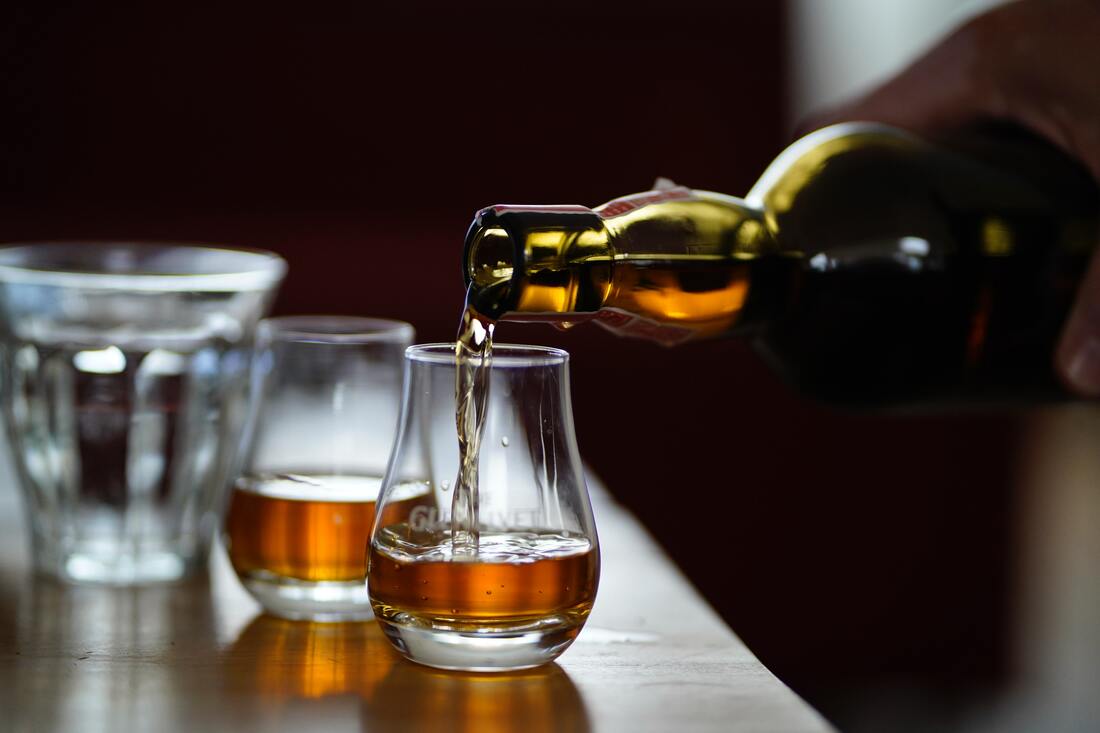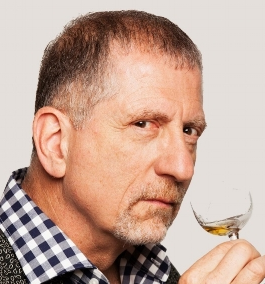|
I'd like to welcome Robin Robinson as a guest blogger this week. We connected through Whiskies of the World and our mutual love of this distilled spirit. If you've ever considered visiting a distillery within the US or on your travels abroad, Robin shares how the whiskey experience has evolved over time. Here's Robin... My first trip to a whisky distillery happened at a time when they were mostly regarded as manufacturing facilities open to employees only, save the rare visit from an out of town friend or distributor. In the late 1990s, I knocked at the side door of the Talisker Distillery on the Isle of Skye in Scotland and was met by a gruff lady who admonished me to “don’t touch nothin’”. She led me around a large room in a perfunctory tour (“this does that” and “those things do this”) but what I remember is the sweet, bready smell of cooked barley, and knowing I was about to fall in love. The giant pot stills in front of me silently cooked the beer mash that would produce the vapor that would one day be my favorite whisky in the world, the reason I came all this way from my home in the US. After the tour, we (along with a few German tourists, more about them later) were led into a small gift shop and given a “wee dram” of the whisky in a glass to drink while she encouraged us to buy some of the souvenirs around us. From my back pocket, I fished out the letter that was written to me by a certain Ian MacDonald from Talisker. I started a correspondence with him about 10 years earlier, after I finished my first bottle of Talisker Single Malt Scotch whisky and became so overwhelmed by the experience that I wrote a fan letter to “Mr. Talisker”. Somehow it got to Mr. MacDonald and after a few weeks he wrote back, imploring me to visit them. It took 10 years but I did and soon Ian MacDonald himself appeared before me, excited to meet his long-time pen pal from America. He led us all into the dunnage warehouse next door and for the first time, I came in touch with the smell that has literally led me by the nose ever since, the smell of wood-influenced ethanol wafting through an old, musty and humid warehouse. It is the smell of whisky maturing, rows and rows of barrel after barrel, waiting for the right time to be released from their “bond” and bottled. MacDonald banged a wooden mallet on the side of the barrel until the “bung” (the wooden stopper) popped out of the “bung hole” (this is why it's fun to hang out with warehousemen, their language is the most colorful). He then inserted the “valinch” (a long copper tube with a handle on one end and a small airhole) into the barrel, extracted a tube full of whisky and sprightly poured it into our waiting glasses and all over our hands, laughing and imploring us to “rub it in, don’t waste it”. Right there, in that moment in time, I fell in love with whisky: the taste and smell of it, the look of it, the idea and the history of it. Since then, I’ve visited over 150 distilleries on 3 continents but you never forget your first time. Today, the whisk(e)y industry has barreled out of obscurity to land in your backyard and instead of the furtive knock on the side door, the red carpet has been rolled out for you. The grumpy lady has morphed into a smart, articulate tour guide who knows the ins and outs of the mash tuns and fermenters and deftly weaves those technical details into a compelling story. Millions are being spent on historical displays, interactive kiosks and virtual walks through the still itself to create an unforgettable experience, whether it be in one of the traditional whiskey regions, obscure locales around the world or right down the street from you in that empty warehouse. Since the start of the 21st century, the course of whiskey has changed dramatically. In the decades leading up to it, it was the ignored drink of old men in dark bars, created by a few global giants like Seagram’s, Schenley and Hiram Walker. Tastes had changed in the 1970s toward lighter spirits like vodka and gin, not to mention the explosion of good wine led by California and Australia, which spawned a whole new trade in wine tourism. But around 20 years ago, whiskey making was brought down to a local level with the surge of small micro-distillers experimenting locally. To give a statistic that drives home the impact of the movement, consider what it takes to open a distillery. In the US, tens of thousands of dollars must be spent on equipment and locale before you can apply for the necessary federal license (called a Distilled Spirits Producer, or DSP) necessary to begin production. In 2000, there were approximately 60 DSPs in the US, including the large traditional distilleries in Kentucky like Jim Beam, as well as the massive alcohol producers like Archer Daniels Midland. But at the end of 2019, the estimate was around 2100 DSPs granted. This explosion of distilling in America and the wide variety of products it produces inspired entrepreneurs around the world to do the same, and now, the only continent not producing spirits like whiskey is Antarctica (well, at least not at this writing). And how best to get you to try their wares? Invite you into their house: whiskey tourism is the new, hot way to explore the world. Kentucky and Scotland lead the pack. In 2009 there were only 8 distilleries in Kentucky; there are now 68. The Kentucky Bourbon Trail was an idea put together by both state legislators and the bourbon industry to turn the state into the “Napa Valley of whiskey” and in 2018 it produced over one million visits. Leading the pack is Buffalo Trace, home of Blanton’s and Pappy Van Winkle, with almost 300k visitors in 2019, up 35% from the year before. Initially conceived to cover the area between Bardstown and Lexington, the “trail” now is split into 5 different regions around the state, from the Ohio River in the north to Danville in the south and has spawned a “Craft Distillery Trail” to cover the smaller facilities along the way. And its only a stone’s throw away from Jack Daniels in Tennessee. Downtown Louisville has created “Whiskey Row” lined with new distilleries (Michter’s and Angel’s Share) to the massive Evan Williams Bourbon Experience. And along the way, plenty of great restaurants, bars and blues joints serving all the whiskey you can imagine. In Scotland, there are currently 122 malt distilleries generating 2 million plus visitors in 2019, up a whopping 56% since 2010. Throughout the country, there are 66 Scotch whisky visitor centers open to the public. Prior to the boom in US micro distilling, no other country on Earth held as many distilleries dedicated to whisky making, which will give you some insight into how the industry, and the product it produces, is regarded by the natives. From the aforementioned Talisker distillery on the Hebridian Isle of Skye (“before you die, visit Skye”) in the North Atlantic, through the rough rolling hills of the Highlands to visit the brand new Macallan distillery of the future; then into the pocket of one of the most beautiful cities in Europe, Edinburgh, to visit the Johnnie Walker Experience, Scotland offers breathtaking views, modern and traditional cuisine and a host of friendly Scots ready to partake in a wee dram with you. Scotland is home to both the Speyside Whisky Festival in the Speyside region as well as Feis Isle, the 8 day celebration of their native spirit on the Isle of Islay. And yes, it’s packed with Germans and Swedes, the biggest fans of the smokey, peaty whiskey that finds its home there. Ireland had practically forgotten it distilled whiskey for most of the 20th century. Coming down from a high of 200 distilleries at the start of the 1900s, by the end of that hundred years it had only 3. Now, distilling fever burns hot and the country is expecting to have 45 distilleries up and running, making gin, vodka and of course, Irish whiskey. Starting in the heart of Dublin, once home of the Big Three – Jameson, Powers & Roe- you can visit the new Teeling and Pearce Lyons distilleries as well as the Jameson Experience Center; you can circumnavigate the Emerald Isle, down the coast through Walsh and Waterford distilleries; stop in Cork to the largest pot stills in the world at Midleton; out to West Cork and Dingle on the Wild Irish Way; before making it inland to Tullemore Dew, Kilbeggen and up into Northern Ireland to visit Bushmill’s. It’s one of the most thrilling auto rides you’ll ever take and each stop will take you through time to when Ireland was king of the whiskey making world. But wait: across the English Channel in France is Brittany, home to Amorik, one of the oldest grain distilleries in France, making their eponymous Single Malt; over to Rozelieures in Alsace Lorraine, makers of rich, smoky and complex whiskies. France is the largest consumer of blended Scotch whisky in the world and while we may know it for its wine and brandies, over 20 new grain-based distilleries have opened up dedicated to whisky making. From there you can hop over to Austria to visit Riestbauer and sample their whiskies aged in wine casks. Need to travel further? How about to Japan, where world class whisky making has been going on since the 1920s from both Suntory and Nikka distilleries. Suntory’s Yamazaki distillery sits at the confluence of 3 rivers and next to a Shinto shrine outside of Kyoto, Japan’s most revered city. Massive and modern, its shows its reverence for tradition with the presence of its founder, Shinjiro Torii and his son Keijo Saji, honored in larger than life copper statues next to the blending museum and tasting gallery. Entering the massive still room with its 12 gleaming copper stills lined up in 2 rows like sentries for inspection, there is a stillness in the air that almost gives a sense of the sacred. Up north on the island of Hokkaido is where the “father and mother of Japanese whisky”, Masataka Taketsuru and his Scottish wife Rita, moved to start up Nikka Distillery in the small fishing village of Yoichi in the 1930s. Emulating the Scottish distilleries where he worked as a visiting apprentice (and where he met Rita), the granite-walled gathering of out- buildings looks more like a college campus than a factory. There, you can visit the living quarters of “Massan” and Rita, where their clothing still hangs in the closet, his pipe is next to the easy chair and what’s left of Rita’s plum pudding is still inside the massive ceramic crock in the kitchen. Gorgeous and idyllic in the summer, the real draw is to show up in February to catch the Snow Building Festival in nearby Sapporo. Be sure to seek out Chichibu in the mountains above Tokyo, home to the next wave of hand-crafted blending by Ichiro Acuto, the next superstar of Japanese whisky. Off to India to Goa, the tiny, tropical state on the Arabian Sea with its fine white sand beaches, where you’ll discover the Paul John Distillery cut out of the dense jungle. Making world class single malt whisky from Indian barley, their new visitor center evokes the diversity of the Indian sub-continent with a nod to its colonial past, welcoming you in colorful hospitality. A short plane trip takes you to the heart of Bangalore to the new distilling facility at Amrut, the giant alcohol maker that started India’s journey toward world-class single malt whiskies. There, pulsing to the beat of this densely populated city, you’ll see the old and new worlds of whisky coming together: the rum-based spirit that slakes the thirst of the millions of working people; and the world class single malts that have been taking home gold medal awards since 2013. It’s a small world, and we haven’t even begun to talk about Australia and South Africa, Germany and Brussels, Wales and Sweden and Denmark. If you live near New York City, there are at least 8 in Brooklyn alone, and dozens up the Hudson River leading through the Adirondack Mountains to the Finger Lakes. Denver has a dozen within the city limits. The wine country of Northern California (the actual epicenter of the movement) grows a new distillery every few months. Texas hosts close to 100 from the panhandle to the boot. Chicago and nearby environs has around 20. From the top of Minnesota to the hills of San Diego and over to the beaches of St. Augustine, distilleries will pop up on Google maps like whack-a-mole. And you once thought whiskey was just something you shoot past your tongue and doused with a beer. Silly you. Whiskey is an experience that ties your sense of smell and taste to what you hear and see, wraps it in a ribbon of history and plants it in your deepest thoughts. And it’s waiting there for you to encounter it, glass by glass, moment by moment. Bon voyage, cheers, kampai and slainte mhaith! by Robin Robinson Whiskey expert Author of The Complete Whiskey Course: A Comprehensive Tasting School in Ten Classes and proprietor of the Whiskey and...podcast, Robin Robinson has built small brands for most of his working life and is currently working with small spirit brands across the US as a “brand sherpa” to help them enter and endure a volatile and competitive marketplace. |
AuthorSharing my travel experiences and insights Archives
July 2024
|
|
Click here to schedule a free consultation about your next trip! (408) 718-4872 [email protected] |
Affiliate of KHM Travel Group
California Seller of Travel Registration # 2089491-50. Registration as a seller of travel in California does not constitute the state's approval. Agent is not a participant in the Travel Consumer Restitution Fund. Florida Seller of Travel Registration # ST37113. Hawaii Seller of Travel License # TAR 7231. Washington Seller of Travel UBI # 602 775122.
California Seller of Travel Registration # 2089491-50. Registration as a seller of travel in California does not constitute the state's approval. Agent is not a participant in the Travel Consumer Restitution Fund. Florida Seller of Travel Registration # ST37113. Hawaii Seller of Travel License # TAR 7231. Washington Seller of Travel UBI # 602 775122.
Managed by Voyager Websites



 RSS Feed
RSS Feed




